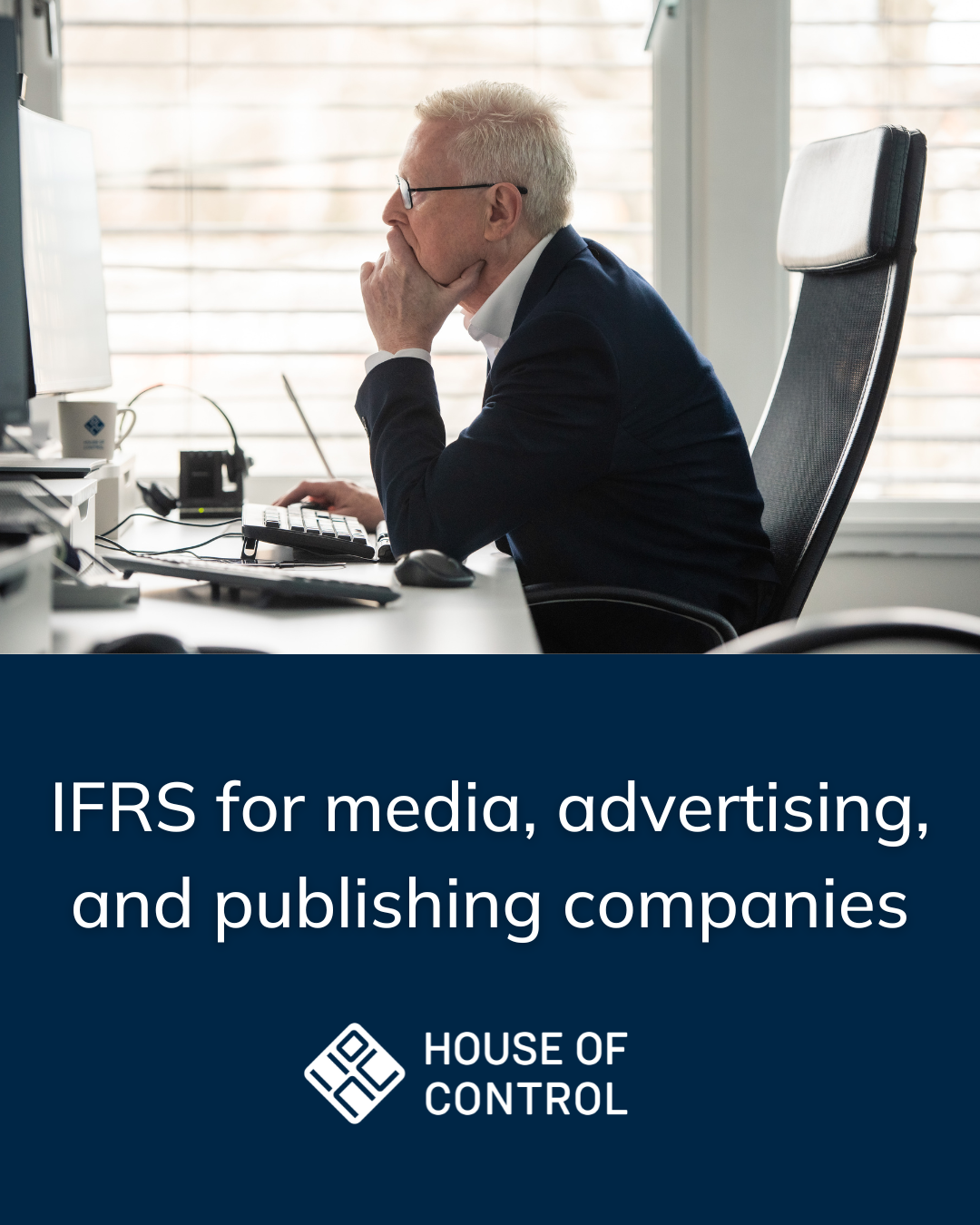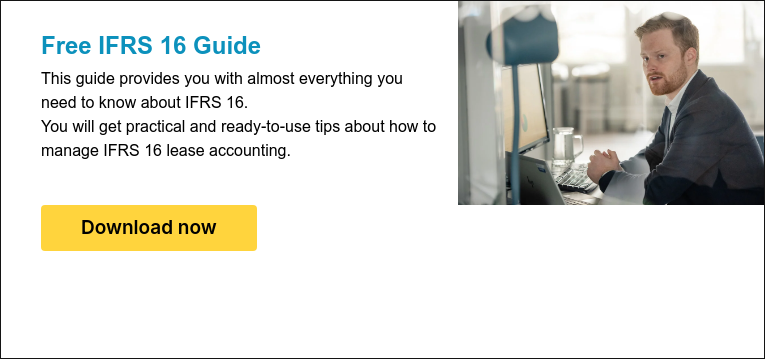IFRS 16 compliance presents a unique set of challenges for companies operating in the media, advertising, and publishing industry. These challenges mainly revolve around leasing office spaces, but also advertising spaces and studio equipment. Here's what finance teams in these industries should consider and how to tackle these distinct IFRS 16 challenges.
Finance professionals in media, advertising, and publishing encounter a variety of industry-specific challenges when it comes to IFRS 16 lease accounting:
- Office spaces: We have looked into the annual reports of companies such as Bonnier, Schibsted, Publicis Groupe, and Omnicom Group. Well above 90 percent of right-of-use closing balances come from building leases.
- Advertising space leases: Companies in this industry often lease advertising spaces, billboards, and promotional spots. Each of these leases may have different terms and conditions, making lease management complex and challenging to account for accurately under IFRS 16.
- Studio and equipment leases: The media sector frequently relies on leased studio equipment, cameras, and editing suites. These leases can vary widely and must be carefully assessed and reported in compliance with IFRS 16.
- Dynamic lease portfolios: Media, advertising, and publishing companies typically manage a dynamic portfolio of leases across various regions and markets. These global operations add complexity to lease accounting and require adherence to IFRS 16 across different regulatory environments.
- Unique lease terms: Lease agreements in this sector can include provisions specific to advertising and media, such as pricing models based on viewership or advertising performance. These unique terms must be incorporated into IFRS 16 calculations.
However, these IFRS 16 and lease accounting challenges are not the only concerns for CFOs and finance teams in the media, advertising, and publishing industry.

advertising, media and publishing finance teams also struggle with these challenges
The IFRS 16 and lease accounting challenges come in addition to a raft of other industry specific challenges that CFOs and finance teams in advertising, media, and publishing.
Dynamic advertising market: Companies need to respond swiftly to shifts in the advertising market, adjusting campaigns, spaces, and budgets accordingly. This requires agile financial planning and analysis.
Digital transformation: As media consumption trends change, companies must invest in digital platforms and content delivery. CFOs play a critical role in ensuring these investments are financially viable and profitable.
Digital advertising analytics: Finance teams need to incorporate data analytics into financial planning to evaluate the effectiveness of digital advertising campaigns and optimize spending.
Royalty and licensing agreement management: Managing licensing agreements for content and ensuring compliance with copyright laws is a continuous task. Finance teams should leverage software solutions that assist in tracking royalties and licensing fees accurately. This ensures compliance with copyright laws and transparent financial reporting.
Data-driven decision-making: Incorporate data analytics into financial planning to assess the performance of digital advertising campaigns. Analyzing data on user engagement, click-through rates, and conversion rates helps optimize advertising spending.
Lease or purchase? IFRS 16 considerations for the advertising, media, and publishing industry
In the fast-paced world of advertising, media, and publishing, determining whether to lease or purchase equipment and assets can be a strategic financial decision. However, like manufacturing, this industry also faces unique IFRS 16 challenges when evaluating these options.
The lease vs. purchase dilemma: Advertising, media, and publishing companies often grapple with the decision of whether to lease or purchase assets like studio equipment, office spaces, or even advertising slots. To make an informed choice, several factors must be weighed:
Upfront costs vs. monthly payments: It's essential to compare the initial costs of purchasing equipment with the ongoing monthly lease payments. Consider how each option will impact your company's cash flow, operating expenses, and overall financial health. In the dynamic media environment, leasing can offer flexibility, allowing swift upgrades to cutting-edge equipment as technology advances, while purchasing may risk locking you into outdated assets.
IFRS 16 and its impact: IFRS 16 plays a pivotal role in shaping financial reporting for advertising, media, and publishing companies. This accounting standard mandates that future lease payments must be recorded as liabilities on the balance sheet, providing stakeholders with a clearer picture of a company's financial obligations. IFRS 16 prescribes guidelines on recognizing, measuring, presenting, and disclosing lease agreements.
Steps towards IFRS 16 compliance
Navigating IFRS 16 compliance for advertising, media, and publishing companies involves several steps:
- Lease identification: Begin by reviewing all existing contracts to identify those that qualify as leases under IFRS 16. This includes not only traditional leases but also agreements for assets like studio equipment or office spaces.
- Lease term assessment: Determine the lease term for each contract, considering options for extension or termination that are reasonably certain to be exercised.
- Lease payment calculation: Calculate the lease payments for each agreement, including any variable payments dependent on indices or rates.
- Discount rate determination: Establish the discount rate for calculating the present value of lease payments. Typically, this is the incremental borrowing rate, reflecting the cost of borrowing funds for asset purchases.
- Asset and liability recognition: Recognize right-of-use assets and lease liabilities on the balance sheet for each lease. Amortize the assets evenly over the lease term and record the liability at the present value of lease payments.
- Disclosure requirements: Provide necessary disclosures in the financial statements' notes, including details about lease nature, payment amounts and schedules, and the carrying values of lease liabilities and right-of-use assets.
To effectively address these challenges and ensure IFRS 16 compliance, advertising, media, and publishing companies should consider specialized lease accounting software.
This software can streamline lease management, enhance data accuracy, and provide efficient reporting, making it an indispensable tool in navigating the complex landscape of lease accounting in this dynamic industry.
Six strategies for IFRS 16 compliance in the advertising, media, and publishing industry
Just as companies in other industries encounter unique IFRS 16 challenges, finance teams in the advertising, media, and publishing industry must also navigate their specific lease accounting complexities.
Here are six strategies tailored to address these challenges and maintain IFRS 16 compliance:
- Utilize industry-specific lease accounting software: To streamline lease management, consider implementing lease accounting software designed to meet the specific needs of the advertising, media, and publishing sector. These specialized tools can automate lease data collection, calculations, and reporting, ensuring that your organization remains compliant with IFRS 16.
- Establish a centralized lease database: Create a centralized lease database to capture all lease agreements, including those related to equipment, studio spaces, and office facilities. A centralized repository enhances visibility and simplifies lease administration, making it easier to monitor and manage your lease portfolio effectively.
- Promote cross-functional collaboration: Collaboration among finance, procurement, and operations teams is essential. Encourage clear communication to ensure accurate lease data and promote compliance with lease accounting standards. In the fast-paced world of advertising and media, accurate data is critical for informed decision-making.
- Prioritize continuous training and education: Keep your finance teams well-informed and up-to-date on evolving lease accounting standards and industry-specific challenges. Regular training and education programs help your staff stay compliant and proficient in lease accounting practices.
- Seek professional guidance: Consider seeking advice from accounting professionals or consultants who are well-versed in lease accounting, especially in the advertising, media, and publishing sector. Their expertise can help navigate complex lease arrangements and ensure full compliance with IFRS 16.
- Implement rigorous audit and review procedures: Establish a robust audit and review process to promptly identify and rectify any lease accounting discrepancies. This proactive approach helps maintain the integrity of your financial data and ensures that your company remains in compliance with IFRS 16.
More on specific IFRS 16 challenges for the industry
While the challenges in advertising, media, and publishing might differ from other industries, they are no less complex:
Diverse lease types: Leases in this industry span a wide range of assets, from office spaces to specialized studio equipment. Identifying and classifying these leases correctly is often a complex task.
Allocation of costs: Properly separating costs between lease and non-lease components, as required by IFRS 16, can be tricky. Lease agreements often include incentives, like rent-free periods, making the allocation of payments more intricate.
Data management: With numerous leases and complex terms, data management becomes a critical concern. Tracking and reporting on lease agreements, especially using manual methods like Excel spreadsheets, can be highly inefficient.
Leveraging lease accounting software
For many advertising, media, and publishing companies, the number of leases surpasses 15, making dedicated lease accounting software a valuable tool for compliance with IFRS 16.
These software solutions can seamlessly integrate with your existing systems, including ERP, to enhance lease management and reporting.
In the dynamic and data-intensive world of advertising, media, and publishing, staying compliant with IFRS 16 is essential for financial transparency and strategic decision-making.
By implementing these strategies and leveraging specialized lease accounting software, your organization can effectively address the unique challenges posed by lease accounting standards in this industry.
The impact of IFRS 16 on financial statements in the advertising, media, and publishing industry
IFRS 16 brings significant changes to financial statements in the advertising, media, and publishing industry:
- Balance Sheet: Lease liabilities and right-of-use assets are added to the balance sheet. This enhances transparency by providing stakeholders with a more comprehensive view of the company's liabilities and assets. It also affects the equity section, as lease liabilities are long-term liabilities that decrease equity.
- Profit and Loss Statement: Lease payments, previously classified as operating expenses, are now split into interest expenses and amortization of right-of-use assets in the income statement. This adjustment may impact profitability measures.
- Cash Flow Statement: Lease payments are divided between the financing activities and operating activities sections of the cash flow statement, reflecting the financing nature of leases.
- Notes to Financial Statements: Companies are required to provide additional disclosures in the notes to the financial statements. These disclosures include information about the nature of leases, payment amounts and schedules, lease terms, and the carrying values of lease liabilities and right-of-use assets.

